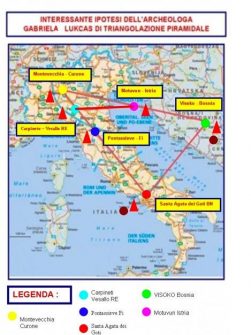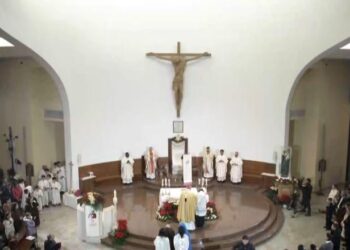shkruan Fahri Xharra
Siçilia, ishulli më i madh i Mesdheut (26 000 kilometra katrorë), ishte udhëkryqi i madh i shumë qytetërimeve që dëshmon për praninë njerëzore që nga koha e Pleistocenit, ku mund të shihen e dhe vizatimet në shpellat e Sicilisë prej 6.000 – 8.000 vjet BC (Roma fliste shqip, “Sicilia e lashtë, faqe 138).
Ky ishull ishte edhe skenë e episodeve të shumta të jetës mitologjike dhe trashëgimia kulturore është shumë e pasur; për çudi e vetmja trashëgimi që nuk përmendet janë piramidat e saj. Roma nuk i ka përmendur as gurët ciklopikë, as hutët shtatlartë (stonhenge, menhir) e as piramidat. Pse?
Homeri, kur shkruan për Sicilinë ai e quan Sikania (ose në tekset e vjetra Sikelia) dhe flet pë bjeshkët e Sikanisë. Njëri nga tre popujt e këj ishulli quheshin Sikanët (Sicanoi), përafërisht 3 000 – 1800 BC. Disa gjuhëtarë e thonë që në Spanjë është lumi Sicano. Emri e këtij populli (pellazg fxh) vjen nga fjla “sika”, duke shpjeguar që ajo vegël gjendej në luginat ku ata jetonin, vegël e kohës së Neolitit. (Their name probably comes from the word “sika”, designating the chalcedony that has been found in great quantities in the valleys where they lived and which they used to make their Neolithic tools).
Pse shkrimet europiane nuk e thonë që kjo ishte thika? Nuk e dinë shqipen apo nuk duan ta dinë dhe të flasin që edhe pra Romës, flitej shqipja?
Pra, ky popull quhej ilirisht “Thikasit” (lexo Fahri Xharra “Roma fliste shqip”, Kush ishin “sikanët” faqe 138).
Në Siçili sipas një studjuesi francez, andej pari gjënden mbi 30 piramida (gigalresearch.com).
Piramidat e Sicilisë paraqesi një strukturë arkitektonike të mrekullueshme, nga një kaluar shumë e largët. Të gjitha piramidat janë një mister në veti, ku shumë studjues të pavarur e cilësojnë origjinë unike kulturore të mileniumeve të kaluara; posaçërisht, pavarësisht pozitës gjeografike, piramidat kanë shumë gjëra të përbashkëta; një orientim me drejtim kardinal, një vijë astronomike me Siriusin ose me tre yjet e Orionit, ose ose me yjet, në harmoni me hyjnitë e popullit që i ka ndërtuar.
Duke i falëmnderuar vështrimit satelitor, arkitekti Vincenzo Di Gregorio në vitin 2001 e ka zbulluar formimin tre-bregor, të ndërtuara, modeluara nga njerëzit e kohës, të cilat shërbenin si qendra astronomike apo hyjnore te shenjta.
Por, arkeologu i përmendur e ka gjetur që piramidat e quajtura të Montevecchia-s, në Val Curone, Lombardy, janë të ngjashme, nëse jo me madhësi, por me pozitë dhe orientim astronomik me piramidën e Gizës (Egjipt). Edhe këtu Di Gregorio thotë punohet pak, kur dihet që format e para të bujqësisë datojnë rreth 11 000 vjet BC., ndërsa piramidat janë ndërtuar qënga vitet 10 000 -3000 BC.

Arkeologia e Vjenës Gabriella Lucasz, me titullin profesor i Universitetit të Pittsburghut e ka ba një barazim vijor të piramidave të Italisë me atë të Bosnjes. Vizatimi tregon dhe qartë shihet që piramida Vesallo (Reggio Emilia) është me një vijë me ato të Sant’Agata dei Goti, Pontassieve, Vesallo-Montevecchia, Curone. Duhet të theksohet që Vesallo është e vendosur në lartësinë e piramidës the Motuvun (Istër), kurse ajo e Sant’Agata dei Goti është në të djathtë të piramidës në Visoko (Bosnje).
Trekëndëshi vjenez i piramidave
Kush i ndërtoi këto piramida? Popujt e detit – pellazgët.
(për më shumë : Who Built the Sicilian Pyramids? These buildings have architectural characteristics similar to those of the pyramids of Güímar and this would suggest a very ancient origin for their construction. According to scholars, the Sicans may have been, before the arrival of the Sicani (and therefore before the 15th century BC), the same people who built some pyramidal structures in central Sicily.
According to a more fascinating thesis, the pyramids of Etna were built by the Šekeleš (or Shekelesh), a tribe of the Sea Peoples coming from the area of the Aegean Sea, and some archaeologists say they were the ancestors of the Sicans (or the Sicans themselves).
According to British archaeologist Nancy K. Sandars, the Shekelesh built the pyramids. Originating in south-eastern Sicily, these people were experts in navigation. And many discoveries, such as amphorae at Monte Dessueri (near Gela, Sicily), are totally identical to those found in Azor, near Jaffa (Israel). Thanks to their mastery in navigation, they reached Tenerife and the island of Mauritius, building pyramids identical to those found in Sicily.
In the Odyssey, Homer refers to Sicily as Sikania and in classic texts it is called Sikelia – this is the origin of the name Sicans. These people were probably already there between 3000 and 1600 BC, then they amalgamated with the Neolithic population.
Evidence for the existence of another culture comes from the Bronze Age and classical antiquity: the Elysani (or Elymians, to whom the construction of the Temple of Segesta is attributed and the creators of a still undeciphered language) who emigrated from Anatolia and could be the descendants of the famous Peoples of the Sea. Thucydides reports that they were refugees who fled from Troy.
The survivors could be a group of Trojans who fled by sea and settled in Sicily and mingled with the Sicans. Virgil writes that they were led by the hero Aceste, king of Segesta in Sicily, who helped Priam during the war and welcomed the fugitive Aeneas, aiding him in the burial of his father Anchise in Erice (Erix).
Referencat:
Fahri Xharra: “ Roma fliste shqip” Prishtinë2019 ( Kush ishin Sikanet ? faqe 148 )
http://piramidasunca.ba/bs/component/k2/item/3339-pyramids-in-sicily.html)
Gjakovë – 05.02.20










